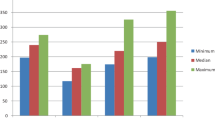Abstract
Purpose
The objective of this pilot study was to establish an animal model for intra-abdominal infection and to examine the effect of sildenafil on anastomotic healing of the left colon and intra-abdominal adhesion formation.
Methods
Fourteen Winstar rats underwent colonic transsection and primary anastomosis after performing intra-abdominal infection. Rats were divided into two groups: Group 1 (n = 7): intra-abdominal infection, resection, and anastomoses; Group 2 (n = 7): intra-abdominal infection, resection, anastomoses, and sildenafil. Anastomotic bursting pressures, hydroxyproline levels, histopathologic grading, and abdominal adhesions were accessed on the postoperative Day 7.
Results
Anastomotic healing was found to be improved in terms of a bursting pressure (P = 0.02). Histopathological examination revealed an increase in angiogenesis (P = 0.007). Moreover, intra-abdominal adhesions were significantly less in rats given sildenafil (P = 0.03).
Conclusion
Sildenafil may improve anastomotic healing of the left colon and diminishes peritoneal adhesion formation in the presense of abdominal infection.


Similar content being viewed by others
References
Batukan C, Ozgun MT, Basbug M, Muderris II. Sildenafil reduces postoperative adhesion formation in a rat uterine horn model. Eur J Obstet Gynecol Reprod Biol 2007;135:183–7.
Reijnen MM, Bleichrodt RP, van Goor H. Pathophysiology of intra-abdominal adhesion and abscess formation, and the effect of hyaluronan. Br J Surg 2003;90:533–41.
Ecthenacher B, Mannel DN, Hultner L. Critical protective role of mast cells in a model of acute septic peritonitis. Nature 1996;331:75–6.
Malaviya R, Ikeda T, Ross E, Abraham SN. Mast cell modulation of neutrophil influx and bacterial clearance at sites of infection through TNF-alfa. Nature 1996;381:77–80.
Cahill RA, Wang J, Sookhai S, Redmond HP. Mast cells facilitate local VEGF release as an early event in the pathogenesis of postoperative peritoneal adhesions. Surgery 2006;140:108–12.
Liebman SM, Langer JC, Marshall JS, Collins SM. Role of mast cells in adhesion formation. Am J Surg 1993;165:127–30.
Regenet N, Pessaux P, Hennekinne S, et al. Primary anastomoses after intraoprrative colonic lavagen vs. Hartmann’s procedure in generalized peritonitis complicating diverticular disease of the colon. Int J Colorectal Dis 2003;18:503–7.
Zorcolo L, Covotta L, Carlomagno N, Bartolo DC. Safety of primary anastomosis in emergency colorectal surgery. Colorectal Dis 2003;5:262–9.
Kaleli B, Ozden A, Aybek Z, Bostanci B. The effect of L-arginine and pentoxifyllin on postoperative adhesion formation. Acta Obstet Gynecol Scand 1998;77:377–80.
Ozden A, Bostanci B, Sarioglu A, Taskiran D, Tetik C. Effect of nitric oxide on postoperative adhesion formation. Eur Surg Res 1999;31:465–70.
Sarifakioglu N, Gokrem S, Ates L, Akbuga UB, Aslan G. The influence of sildenafil on random skin flap survival in rats: an experimental study. Br J Plast Surg 2004;57:769–72.
Jonsson K, Jensen JA, Goodson WH, et al. Tissue oxygenation, anemia, and perfusion in relation to wound healing in surgical patients. Ann Surg 1991;214:605–13.
Swaim SF, Vaughn DM, Kincaid SA. Effect of locally injected medications on the healing of pad wounds in dogs. Am J Vet Res 1996;57:394–9.
Brasken P. Healing of experimental colon anastomoses. Eur J Surg Suppl 1991;566:1–51.
McCullough AR. An update on the PDE-5 inhibitors (PDE-5i). J Androl 2003;24:52–8.
Hulka JF, Omran K, Berger GS. Classification of adnexal adhesions: a proposal and evaluation of its prognostic value. Fertil Steril 1978;41:661–5.
Woessner JF. The determination of hydroxyproline in tissue and protein samples containing small proportions of this imino acid. Arch Biochem Biophys 1961;93:440–7.
Ehrlich HP, Tarver H, Hunt TK. Effects of vitamin A and glucocorticoids upon inflammation and collagen synthesis. Ann Surg 1973;177:222–7.
Cahil RA, Wang JH, Redmond HP. Enteric bacteria and their antigens may stimulate postoperative peritoneal adhesion formation. Surgery 2007;141:403–10.
Vipond MN, Whawell SA, Thomson JN, Dudley HA. Effect of experimental peritonitis and ischemia on peritoneal fibrinolitic activity. Eur J Surg 1994;160:471–7.
Dorr PJ, Vemer HM, Brommer EJ, Willemsen WM, Veldhuizen RW, Rolland R. Prevention of postoperative adhesions by tissue-type plasminogen activator (t-PA) in the rabbit. Eur J Obstet Gynecol Reprod Biol 1990;37:287–91.
Biondo S, Jaurrieta E, Marti Rague J, DeOca J, Moreno P, Farran L. Role of resection and primary anastomosis of the left colon in the presense of peritonitis. Br J Surg 2000;87:1580–4.
Runkel NS, Hinz U, Lehnert T, Buhr HJ, Herforth CH. Improved outcome after emergency surgery for cancer of the large intestine. Br J Surg 1998;85:1260–5.
Hart K, Baur D, Hodam J, et al. Short- and long-term effects of sildenafil on skin flap survival in rats. Laringoscope 2006;116:522–8.
Irkorucu O, Tascılar O, Cakmak GK, et al. The effect of sildenafil on an animal model for ischemic colitis. Dig Dis Sci 2008;53:1618–23.
Boland GM, Weigel RJ. Formation and prevention of postoperative abdominal adhesions. J Surg Res 2006;132:3–12.
Barnes CD, Eltherington LG. Drug dosage in laboratory animals: A handbook. Berkeley: University of California Press, 1964.
Kologlu M, Yorganci K, Renda N, Sayek I. Effect of local and remote ischemia reperfusion injury on healing of colonic anastomoses. Surgery 2000;128:99–104.
Thornton FJ, Barbul A. Healing in the gastrointestinal tract. Surg Clin North Am 1997;77:549–73.
Aytekin FO, Teke Z, Aydin C, et al. Effects of a membrane-permeable radical scavenger, Tempol, on healing of colonic anastomoses in the cecal ligation and pucture model of polymicrobial sepsis in rats. Am Surg 2007;193:723–9.
Colak T, Nayci A, Polat G, et al. Effects of trapidil on the healing of colonic anastomoses in an experimental rat model. ANZ J Surg 2003;73:916–21.
Author information
Authors and Affiliations
Corresponding author
About this article
Cite this article
Ayten, R., Çetinkaya, Z., Girgin, M. et al. The Effects of Intraperitoneal Sildenafil Administration on Healing of Left Colonic Anastomoses and Intra-Abdominal Adhesion Formation in the Presence of Intra-Abdominal Infection. Dis Colon Rectum 51, 1837–1841 (2008). https://doi.org/10.1007/s10350-008-9398-x
Received:
Revised:
Accepted:
Published:
Issue Date:
DOI: https://doi.org/10.1007/s10350-008-9398-x




